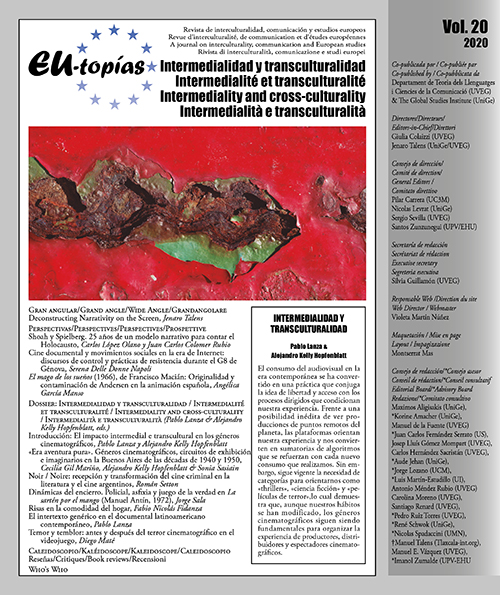Laughter in the Comfort of Home. An Analysis of the Adult Comedies Made for the Video Home Market in the late 1980’s and the early 1990’s in Argentina
DOI:
https://doi.org/10.7203/eutopias.20.19392Keywords:
Comedy, cinema, video, intermediality, film genres. Abstract
Abstract
In a series of brief comments, Jesús Martín-Barbero (1987), posits comedy, along with melodrama, as matrix of Latin American popular culture. This cultural matrix was reworked by different disciplines, among which cinema stands out. When the movie industry incorporates it, reformulating it, it gives birth to different variants among which a type of comedy, focused on sex, managed to become one of the most popular subgenres in all Latin America. In Argentina, this type of comedy was one of the most successful film productions since its beginning. Said kind of comedy, which emerged in the 1960s, continued to be produced until the late 1980s and early 1990s when it abandonded the national movie theaters. However, far from disappearing, it found shelter in the home video market. Based on these considerations, the intention of this work is to address the landing of picaresque comedy into the home video market in order to analyze the continuities and the ruptures that occurred in the passage to a new media, the reformulations of elements from other productions with similar characteristics (television comic programs, the «Teatro de la Calle Corrientes») that was carried out, and the links established with other genres of the local video industry such as the video concert.
 Downloads
Downloads
 References
References
Altman, Rick. Los géneros cinematográficos. Barcelona: Paidós, 2000.
Barbarena, Martín. La inserción del video en el ámbito doméstico y su incidencia en el desarrollo de la cultura audiovisual. Facultad de periodismo y comunicación social-Universidad Nacional de La Plata (Tesis), 2010. MIMEO.
Camarero, Emma. «De lo banal a lo indispensable. Pornochachada y Cinema Novo durante la dictadura brasileña (1964-1985)». L’Atalante. Revista de estudios cinematográficos, 23, 2017, pp. 95-108.
Daney, Serge. «Como todas las viejas parejas, el cine y la televisión terminan por parecerse». Cine, arte del presente, Buenos Aires: Santiago Arcos, 2004, pp. 125-129.
D’Antonio, Deborah. «Paradojas del género y la sexualidad en la filmografía durante la última dictadura militar argentina». Revista Estudios feministas, 23 (3), 2015, pp. 913-937.
Fraticelli, Damián. «Una periodización de los programas cómicos: Paleo, Neo y Humor Post-televisivo». Imagofagia, 8, 2013, pp. 1-19, http://www.asaeca.org/imagofagia/index.php/imagofagia/article/view/421 Recuperado el 1 de octubre de 2020.
Galuppo, Gustavo. «Video, el cine por otros medios». Comps. Jorge La Ferla y Sofía Reynal, Sofía (Comp.). Territorios audiovisuales. Buenos Aires: Libraria, 2012.
Gerchunoff, Pablo y Lucas Llach. El ciclo de la ilusión y el desencanto. Buenos Aires: Ariel, 1998.
Getino, Octavio. Las industrias culturales en la Argentina: dimensión económica y políticas públicas. Buenos Aires: Colihue, 1995.
— Cine argentino. Entre lo posible y lo deseable. Buenos Aires: Ciccus, 1998.
Kessler, Cristina. «Erotismo à brasilera: o ciclo da pornochachada». Sessões do imaginario, 22, 2009, pp. 14-20.
King, Geoff. Film comedy. Nueva York: Wall Flower Press, 2002.
Landi, Oscar. Devórame otra vez. Buenos Aires: Editorial Planeta, 1992.
Lemus Martínez, Violeta. «Erotismo, sexualidad e iconografía en el cine mexicano de Ficheras de los años 1970». América. Cahiers du CRICCAL, 46, 2015, pp. 161-168.
Manzano, Valeria. «Tiempos de destape: sexo, cultura y política en la Argentina de los ochenta». Mora, 25, 2019, pp. 135-154, https://doi.org/10.34096/mora.n25.8526 Recuperado el 1 de octubre de 2020.
Manrupe, Raúl y Alejandra Portela. Un diccionario de filmes argentinos (1930-1995). Buenos Aires: Corregidor, 2001.
Martín-Barbero, Jesús. De los medios a las mediaciones. Barcelona: Gustavo Gili, 1987.
Milanesio, Natalia. «Sex and Democracy: The Meanings of the Destape in Postdictatorial Argentina». Hispanic American Historical Review, 99 (1), 2019, pp. 91-122, https://doi.org/10.1215/00182168-7287984 Recuperado el 1 de octubre de 2020.
Ortiz, María Florencia. «Juegos de palabras». Coord. Ana Flores. Diccionario crítico de términos del humor y breve enciclopedia de la cultura humorística argentina. Córdoba: Universidad Nacional de Córdoba, 2014, pp. 99-108.
Pellettieri, Osvaldo. «Remanencia del sistema premoderno». Ed. Osvaldo Pellettieri. Historia del teatro argentino en Buenos Aires. Volumen V: el teatro actual (1976-1998). Buenos Aires: Galerna, 2001,pp. 227-255.
Rajewsky, Irina. «Intermediality, intertextuality and remediation: a literary perspective on intermediality» Intermédialités, 6, 2005, pp. 43-64.
Ramírez Ferreiro, Jesús. «¿La industria inexistente? (“cine de ficheras” en los ochenta)». Navegando, 6, 2017, pp.4-14.
Sanz, María de los Ángeles. «Historia del café-concert en Buenos Aires. De la música al humor». Teatro y representación. Ed. Roger Mirza, Editor. Montevideo: Universidad de la República, 2011.
s/f. «Aquí podemos hacerlo». Video para usted, 31, 1989.
s/f. «El boom del video concert». Video para usted, 19, 1988.
s/f .«Perciavalle con todo». Video Club, 27, 1985.
Sánchez Noriega, José Luis, De la literatura al cine. Teoría y análisis de la adaptación. Barcelona: Paidós, 2000.
Sorlin, Pierre. Estéticas del audiovisual. Buenos Aires: La Marca, 2010.
Ulanovsky, Carlos, Silvia Itkin y Pablo Sirvén. Estamos en el aire. Una historia de la televisión en la Argentina. Buenos Aires: Planeta, 1999.
Valdez, María. «Sábanas para el amor: el cine de hoteles». Cine argentino. Modernidad y Vanguardias. 1957/1983. Vol. I. Dir. Claudio España. Buenos Aires: Fondo Nacional de las Artes, 2005, pp. 256-257.
Varela, Mirta. La televisión criolla. Desde sus inicios hasta la llegada del hombre a la Luna (1951-1969). Buenos Aires: Edhasa, 2015.
Velleggia, Susana. Cine y espacio audiovisual argentino. Buenos Aires: Instituto Nacional de Cinematografía, 1990.
Downloads
Published
How to Cite
-
Abstract662
-
PDF (Español)281
Issue
Section
License
![]()
The authors conserve the copyright. All content published in EU-topías. Journal of interculturality, Communication, and European Studies are subject to the license Creative Commons Attribution-NonCommercial-ShareAlike 4.0 license. The full text of the license can be found at <http://creativecommons.org/licenses/by-nc-sa/4.0>
They may be copied, used, disseminated, transmitted and publicly displayed, provided that:
- The authorship and original source of the publication is cited (journal, publisher and URL of the work).
- They are not used for commercial purposes.
- The existence and specifications of this license of use are mentioned.
It is the responsibility of the authors to obtain the necessary permissions for images that are subject to copyright.



